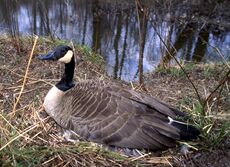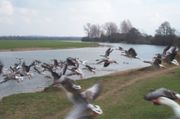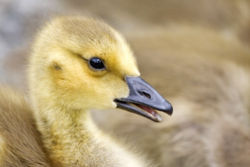|
Geese |

|
|
Scientific classification |
|
|
| Genera |
Anser
Branta
Chen
Cereopsis
Cnemiornis (extinct)
see also:
Swan,
Duck
Anatidae |
Goose (plural geese) is the general English
name for a considerable number of
birds, belonging to the family
Anatidae. This family also includes
swans, most of which are larger than geese, and
ducks, which are smaller.
Introduction
This article deals with the true geese in the subfamily
Anserinae. A number of other waterbirds, mainly
related to the
shelducks, have "goose" as part of their name.
True geese are medium to large birds, always (with the
exception of the Nēnē) associated to a greater or lesser
extent with water. Most species in Europe, Asia and North
America are strongly
migratory as wild birds, breeding in the far north and
wintering much further south. However, escapes and
introductions have led to resident feral populations of
several species.
Geese have been
domesticated for centuries. In the West, farmyard geese
are descended from the
Greylag, but in Asia the Swan Goose has been farmed for at least as long.
All geese eat an exclusively vegetarian diet, and can
become pests when flocks feed on arable crops or inhabit
ponds or grassy areas in urban evnironments.
Geese mate for life, though a small number will "divorce"
and remate. They tend to lay a smaller number of eggs than
ducks, however, both parents protect the nest and young,
which usually results in a higher survival rate for the
young geese, known as goslings.

Greylag Geese flying.
Not all couples are heterosexual, as both females and
males will form long-term
same-sex couples with greater or lesser frequency
depending on species.
Of the heterosexual couples, a significant proportion are
non-breeding despite having an active sexual life. See
Canada Goose
A group on the ground is called a gaggle. When
flying, a group of geese is known as a wedge or a
skein.
Geese have appeared in feature films such as "Fly Away
Home" which starred Jeff Daniels and Anna Paquin.
True geese

Canada Goose gosling
The following are the true goose species.
Genus Anser Brisson 1760, Grey Geese
- Greylag Goose Anser anser
White-fronted Goose A. albifrons
Lesser White-fronted Goose A. erythropus
Bean Goose A. fabalis
Pink-footed Goose A. brachyrhynchus
Bar-headed Goose A. indicus
Swan Goose, A. cygnoides
Genus Chen Boie 1822 or Anser (depending on authority
cited), White Geese
- Snow Goose Chen caerulescens or Anser caerulescens
Ross's Goose, C. rossii or A. rossii
Emperor Goose, C. canagica or A. canagicus
Genus Branta Scopoli 1769, Black Geese
- Brent Goose Branta bernicla
Barnacle Goose B. leucopsis
Canada Goose B. canadensis
Cackling Goose B. hutchinsii
Red-breasted Goose B. ruficollis
Hawaiian Goose or Nēnē, B. sandvicensis
Nēnē-nui or Woods-walking Goose, B. hylobadistes
Conservation status: Prehistoric
Genus Cereopsis
-
Cape Barren Goose, Cereopsis novaehollandiae
Genus
Cnemiornis, New Zealand Geese
Conservation status: Prehistoric
- South Island Goose, Cnemiornis calcitrans
Conservation status: Prehistoric
North Island Goose, Cnemiornis gracilis Conservation
status: Prehistoric
Other species called "geese"
There are a number of mainly southern hemisphere birds
named as geese which are more correctly placed with the
shelducks in the Tadorninae. These are:
- Blue-winged Goose, Cyanochen cyanopterus
Andean Goose, Chloephaga melanoptera
Magellan Goose, Chloephaga picta
Kelp Goose, Chloephaga hybrida
Ashy-headed Goose, Chloephaga poliocephala
Ruddy-headed Goose, Chloephaga rubidiceps
Orinoco Goose, Neochen jubata
Egyptian Goose, Alopochen aegyptiacus
The
Spur-winged Goose, Plectropterus gambensis, is
most closely related to the shelducks, but distinct enough
to warrant its own subfamily, the
Plectropterinae.
The three
perching ducks in the genus Nettapus are named as
pygmy geese, such as the
Cotton Pygmy Goose, Nettapus javanica, but are
true
ducks.
The unusual
Magpie-goose is in a family of its own, the
Anseranatidae.
Etymology
Goose in its origins is one of the oldest words of
the Indo-European languages, the modern names deriving from
the proto-Indo-European root, ghans, hence Sanskrit hamsa (feminine hamsii), Latin
anser, Greek khén etc.
In the
Germanic languages, the root word led to Old English gos
with the plural gés, German Gans and Old Norse gas. Other
modern derivatives are Russian gus and Old Irish géiss; the
family name of the cleric Jan Hus is derived from the Czech derivative husa.
In non-technical use, the male goose is called a "gander"
(Anglo-Saxon gandra) and the female is the "goose" (Webster's
Revised Unabridged Dictionary (1913))
See also




